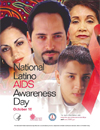Archive: Have you heard?
January 8, 2008

Salmonella, a group of bacteria that can cause diarrheal illness, are microscopic living creatures that pass from the feces of people or animals to other people. Most persons infected with Salmonella develop diarrhea, fever, and abdominal cramps 12 to 72 hours after infection. For more information on the ongoing, multistate salmonella outbreak, click here.
January 5, 2008

Neural tube defects (NTDs), major birth defects of a baby’s brain or spine such as spina bifida and anencephaly, are preventable. Affecting 3,000 pregnancies a year, NTDs can be prevented by taking B vitamin folic acid before and during pregnancy. Help CDC celebrate National Folic Acid Awareness Week » Learn more
December 29, 2008

About 75% of the alcohol consumed by adults in the U.S. is in the form of binge drinking (4 or more drinks for a woman and 5 or more drinks for a man, in one day). Make sure that you are celebrating the New Year right by being safe when it comes to consuming alcohol. »Learn more
December 22, 2008

Clean, separate, cook and chill. This four-word motto can help save your holiday meal and prevent the spread of foodborne diseases like salmonella or e. coli. Use our formatted releases or check out how you can keep the germs away. »Learn more
December 15, 2008

Before you sail off into the sunset for a holiday cruise, check out CDC’s Vessel Sanitation program, which allows you to find scores, reports and corrective actions on your favorite Cruise Line or Cruise Ship. » learn more
December 8, 2008

Every year in the United States, on average 5 to 20 percent of the population gets the flu, more than 200,000 people are hospitalized from complications and 36,000 people die from it. This week is National Influenza Vaccination Week. This year’s campaign highlights the importance of continuing flu vaccination to foster greater use of the flu vaccine through the months of November, December and beyond. » learn more
December 4, 2008

The number of people with Alzheimer’s disease doubles every 5 years beyond age 65. The disease usually begins after age 60, and risk goes up with age. About 5 percent of men and women ages 65 to 74 have Alzheimer’s disease, and nearly half of those age 85 and older may have the disease. CDC has joined the Council of State Government’s in recognizing the importance of studying the impact of cognitive impairment and Alzheimer’s disease on public health. The Council of State Government’s issued a brief that addresses the significant health, social, and economic burdens of cognitive impairment and Alzheimer′s disease. » learn more
December 1, 2008

Despite making up 12 percent of the U.S. population, blacks represented nearly half, 46 percent, of all people living with HIV in the U.S. in 2006. Unfortunately, HIV/AIDS affects about 1 million people in the U.S., and of those people, one in five do not know they are infected. CDC has developed better surveillance systems to ensure the accuracy of estimates and provide recommendations and guidelines. » learn more
November 25, 2008

A 2007 study found that if a city increased its green space by 10%, the average surface temperature could cool by up to 4 degrees. Climate change and its affects on public health are unpredictable, but CDC's expertise and programs in environmental health, infectious disease, and other fields form the foundation of public health efforts in preparedness for climate change. » learn more about what CDC is doing
November 17, 2008

A news outlet recently conducted an analysis of CDC′s Behavioral Risk Factor Surveillance System (BRFSS) 2006 data, released August 2008. The outlet ranked some cities healthiest vs. unhealthiest, but CDC does not rank cities. Click here to see the latest surveillance summary report for certain health behaviors and conditions among states and selected local areas. For general information on BRFSS click here.
November 17, 2008

Thursday is the 32nd Great American Smokeout. CDC partners with the American Cancer Society to encourage smokers, approximately 19.8% of adults and 23% of high school students, to quit.
» Learn more on how to quit smoking
November 10, 2008

Clostridium difficile, also known as C. diff or C. difficile, is a bacteria that, when found in large numbers in the intestinal tract of people taking antibiotics or other antimicrobial drugs, can cause diarrhea or life-threatening inflammations of the colon. C. difficile is responsible for tens of thousands of cases of diarrhea and at least 5,000 deaths each year, especially in healthcare settings.
» Learn more
November 6, 2008

According to a recently released report, 62% of chemical incidents reported at elementary and secondary schools resulted from human error or unintentional mistakes in the use or handling of a substance. The federal Agency for Toxic Substances and Disease Registry (ATSDR) conducts national public health surveillance of chemical incidents through its Hazardous Substances Emergency Events Surveillance (HSEES) system.
» Learn more
October 24, 2008

Trying to lose weight? According to a recently-released survey more women than men reported weight loss attempts in the preceding 12 months. Find out more statistics by age group and sex.
» Learn more
October 20, 2008

Respiratory Syncytial Virus (RSV) is a virus common in childhood and important in older adults. It′s the major respiratory virus of early infancy. RSV also can cause severe respiratory illness in people 65 and older. This virus exists worldwide, and, as with the flu, RSV infections occur seasonally. The RSV season varies, depending on where you live, but usually lasts from fall to spring.
» Learn more
October 15, 2008

Preventing Falls Among Older Adults
Unintentional falls are a threat to the lives, independence and health of older adults. And more than 90% of hip fractures among adults ages 65 and older are caused by falls. But falls are not an inevitable part of aging. Proven strategies can reduce falls and help older adults live better and longer.
» Learn more
October 15, 2008

October 15 is National Latino AIDS Awareness Day
HIV remains a significant threat to the health of Latino communities in the United States. Latinos are becoming infected with HIV at a rate three times greater than whites; and while Latinos represent just 15 percent of the U.S. population, they make up 18 percent of those living with HIV/AIDS.
» Learn more
October 8, 2008

The Compendium of Strategies to Prevent Healthcare-Associated Infections in Acute Care Hospitals, a compilation of best practices to preventing and treating patients with infections, was just released along with six patient guides for the infections it covers.
» Learn more
October 2, 2008

Among adults with a disability, Black, Hispanic and Native Americans report fair or poor health at disproportionately higher rates compared with White and Asian Americans.
» Learn more
October 2, 2008

October first marks the opening of flu season and this year the Advisory Committee on Immunization Practices has added new recommendations. Make sure you know the latest changes.
» Learn more
September 26, 2008

CDC′s 19th international conference on Rabies in the Americas (RITA) will be hosted at CDC, September 28-October 3. Highlights of the conference will include an appearance by Jeanna Giese, a rabies survivor, and the signing of a North American Rabies Management plan.
» Learn more
September 25, 2008

The Advisory Committee on Immunization Practices (ACIP) recently expanded its recommendations for influenza vaccination to include all children from six months through 18 years of age.
Get the most recent CDC reports on influenza and influenza vaccination » here.
September 20, 2008

Now that kids are back hitting the books and hitting the field, it′s a good idea to make sure your child is immunized. CDC has put together a recommended regular and catch-up schedule.
» 2008 Childhood and Adolescent Immunization Calendar
September 15, 2008

Chili peppers and figs are September′s Fruit and Vegetable of the Month. Celebrate Fruit and Veggie Matter More Month with the CDC
» Learn More
September 9, 2008

More than 32,000 people kill themselves each year. Men are 4 times more likely to die from suicide, but 3 times more women attempt suicide. Get the facts and help prevent suicide during Suicide Prevention Week.
» Learn More
September 8, 2008

CDC estimates that Americans visit doctors more than 12 million times per year for skin infections typical of those caused by staph bacteria. In some areas of the country, more than half of the skin infections are MRSA. Concerned parents and health providers can help protect families with more information.
» Learn More
September 5, 2008

Preparing for hurricane season is essential for preventing disaster-related health problems. Making a plan and preparing a kit are just two ways you can get ready.
» Learn More
September 4, 2008

Now that kids are back hitting the books and hitting the field, it’s a good idea to make sure your child is immunized. CDC has put together a recommended regular and catch-up schedule.
» 2008 Childhood and Adolescent Immunization Calendar
- Historical Document: November 17, 2008
- Content source: Office of Enterprise Communication
- Notice: Links to non-governmental sites do not necessarily represent the views of the CDC.
Contact CDC:
- Centers for Disease Control and Prevention
1600 Clifton Rd
Atlanta, GA 30333 - 800-CDC-INFO
(800-232-4636)
TTY: (888) 232-6348
24 Hours/Every Day - cdcinfo@cdc.gov

